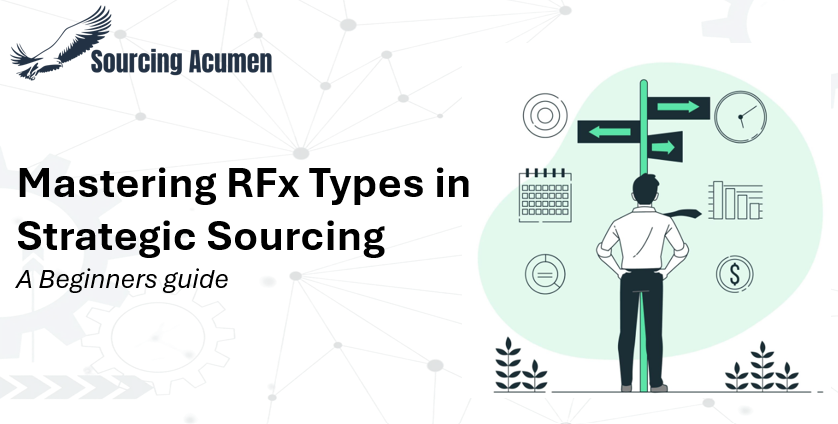
Introduction
In strategic sourcing, choosing the right RFx method is a strategic decision that shapes supplier engagement, unlocks cost savings, and drives long-term value. Whether you’re seeking supplier innovation, price transparency, or regulatory compliance, understanding the distinct roles of RFI, RFQ, RFP, and other RFx types is critical to building an effective sourcing process.
What is RFx?
RFx stands for “Request for X,” where “X” can refer to Information, Proposal, Quotation, Tender, Solution, or Qualification. These formalized processes help procurement teams communicate business needs to suppliers and collect structured responses that support decision making.
Core RFx Types and When to Use Them
RFI (Request for Information)
- Purpose: Exploratory. Used to gather intelligence on supplier capabilities, emerging solutions, or market conditions.
- Use Case: Early-stage sourcing, new categories, unfamiliar markets, or innovation scouting.
An RFI is often the first step in a multi-stage sourcing process. It allows procurement professionals to understand the supplier’s landscape without committing to a specific path forward. By using an RFI, buyers can gather information about suppliers, assess supplier interest, and identify potential risks or opportunities before moving to a more formal bidding process.
RFQ (Request for Quotation)
- Purpose: Price discovery. Used when specifications are well-defined and pricing is the primary selection criterion.
- Use Case: Tactical or transactional sourcing especially for commodities or standardized goods/services.
An RFQ is typically a short, structured document where suppliers are asked to quote prices against a defined set of specifications. Because there is little ambiguity, the RFQ process emphasizes speed, compliance, and cost control. It is ideal for comparing unit pricing, delivery terms, and payment conditions across multiple suppliers.
RFP (Request for Proposal)
- Purpose: Comprehensive evaluation. Used when the buying organization seeks a combination of pricing, quality, service, and innovation.
- Use Case: Strategic categories where suppliers propose tailored solutions e.g., logistics, IT services, marketing, contingent labor, professional services.
RFPs are used when the buyer is seeking the best overall value, not just the lowest cost. These documents often include detailed background information, project objectives, technical requirements, and evaluation criteria. Suppliers are expected to submit narrative responses, innovation strategies, qualitative assessment information like capabilities and experience, and detailed pricing. The evaluation of an RFP is typically collaborative, involving cross-functional teams and weighted scoring models.
RFT (Request for Tender)
- Purpose: Compliance focused. Often used in public sector or regulated environments where formal bids are required.
- Use Case: Government or institutional sourcing where transparency and legal fairness are paramount.
RFTs are governed by strict rules and timelines. They are typically used in jurisdictions that require open competition and documentation for audit purposes. The process must ensure equal access to information and prohibit subjectivity. An RFT often follows a structured format with mandatory submission documents, clear evaluation guidelines, and defined contractual obligations.
RFS (Request for Solution)
- Purpose: Co-creation. Focused on soliciting supplier-led innovation or unconventional approaches to complex problems.
- Use Case: Product design, sustainability initiatives, or digital transformation where buyers invite open-ended proposals.
Unlike RFPs or RFQs, an RFS provides limited direction. The goal is to allow suppliers to think creatively and propose solutions the buyer may not have considered. This method is especially useful in categories undergoing disruption or where collaborative development with suppliers is a competitive advantage. Responses to an RFS are often diverse, which requires a flexible and iterative evaluation approach.
RFQual (Request for Qualification)
- Purpose: Pre-screening. Used to qualify suppliers before they move to the main sourcing event.
- Use Case: Large or critical projects where financial health, technical competency, capabilities, expertise, experience or compliance must be verified.
An RFQual acts as a filter to ensure only capable suppliers are invited to submit bids or proposals. It may include requests for financial statements, certifications, references, and prior project experience. In categories where supplier quality, services & capabilities are equally important as pricing – RFQual is used. This step helps protect the organization from operational risk.
RFI vs RFQ vs RFP: Key Differences
Understanding when to use RFI, RFQ, or RFP is essential for efficient and strategic procurement. Here’s how they differ:
| RFx Type | Purpose | Supplier Input | Best For |
| RFI | Information gathering | Supplier capabilities, serviceability, ideas | Early research, exploring unknown categories |
| RFQ | Price comparison | Pricing based on fixed specs | Commodities, standardized services |
| RFP | Proposal evaluation | Detailed solution proposals | Complex categories, strategic sourcing |
Choosing the right type ensures alignment between procurement strategy and desired outcomes.
Strategic Application of RFx Types
Choosing the right RFx tool depends on the sourcing objective, category complexity, and supplier market maturity.
A helpful rule of thumb:
- Unknown market? Start with an RFI
- Well-defined need? Use an RFQ
- Complex evaluation? Launch an RFP
- Innovative challenge? Try an RFS
- Public sector? Default to RFT
- Critical vetting? Begin with RFQual
For strategic sourcing teams, mapping RFx types to category segmentation models (like the Kraljic Matrix) ensures better alignment between sourcing approach and business risk/value.
Modernizing the RFx Process with Digital Tools
Traditional RFx processes can be time-consuming and siloed. Leading e-Sourcing platforms and strategic sourcing tools now embed automation, AI, and analytics into the RFx cycle, enabling procurement professionals to:
- Reduce cycle time through built-in templates and workflows
- Score and compare supplier responses automatically
- Collaborate with stakeholders in real time
- Generate actionable insights from bid data
Platforms like Sourcing Acumen are reshaping how RFx events are designed and evaluated, putting data driven insights at the heart of procurement decisions.
Conclusion
Understanding the full spectrum of RFx types is foundational for strategic sourcing excellence. By selecting the right approach for each sourcing scenario, procurement teams can drive better supplier engagement, unlock innovation, and create long-term value. Combined with digital RFx tools, the modern sourcing professional is equipped to meet today’s procurement demands with speed, clarity, and strategic intent.




